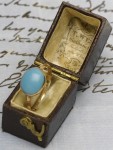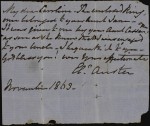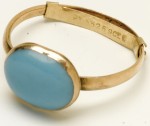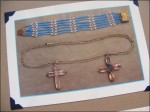 At the Sotheby’s English Literature, History, Children’s Books and Illustrations sale in London this July, a turquoise and gold ring which had once belonged to Jane Austen was purchased for £152,450 ($244,000). As is their wont, Sotheby’s did not release the name of the buyer, but now the buyer has revealed herself. In an interview with British tabloid the Daily Star, singer and first American Idol Kelly Clarkson identified herself as the bidder who won Jane Austen’s ring.
At the Sotheby’s English Literature, History, Children’s Books and Illustrations sale in London this July, a turquoise and gold ring which had once belonged to Jane Austen was purchased for £152,450 ($244,000). As is their wont, Sotheby’s did not release the name of the buyer, but now the buyer has revealed herself. In an interview with British tabloid the Daily Star, singer and first American Idol Kelly Clarkson identified herself as the bidder who won Jane Austen’s ring.
The ring has a flawless provenance. When Jane died in 1817, she left all her possessions to her sister and best friend Cassandra. Three years later, Cassandra gave the ring to Eleanor Jackson, soon to be her sister-in-law as the second wife of her brother Rev. Henry Thomas Austen, the brother Jane was closest to. Eleanor Austen passed it to her niece Caroline, who had known Jane briefly when she was a little girl. It has been kept in the family this entire time, only becoming public knowledge now because of the sale. This ring is the first piece of Jane’s jewelry to come up for auction in a generation.  Included in the lot is a hand-written note Eleanor wrote to Caroline shortly before her death in 1869:
Included in the lot is a hand-written note Eleanor wrote to Caroline shortly before her death in 1869:
“My dear Caroline. The enclosed Ring once belonged to your Aunt Jane. It was given to me by your Aunt Cassandra as soon as she knew that I was engaged to your Uncle. I bequeath it to you. God bless you!”
Unfortunately for Ms. Clarkson, she won’t be wearing Jane’s ring back home. She applied for an export license as required by law, but the Reviewing Committee on the Export of Works of Art and Objects of Cultural Interest advised the Secretary of State not to grant it on the grounds that the object is of national importance. With the export ban in place, the item cannot leave British soil. Kelly is going to have to cross an ocean to visit her ring.
The Reviewing Committee assesses each object according to three criteria established by a 1950 export policy committee chaired by Viscount Waverley. There are three Waverley criteria against which an export item is to be judged:
1. History — Is the object so closely connected with our history and national life that its departure would be a misfortune?
2. Aesthetics — Is the object of outstanding aesthetic importance?
3. Scholarship — Is the object of outstanding significance for the study of some particular branch of art, learning or history?
 Although Jane Austen’s ring is a lovely cabochon natural turquoise, it’s too simple a design, I suspect, to qualify as a national treasure under Waverley two. There is little of scholarship value in the ring. Jane was known to have simple tastes in jewelry, something reflected in her characters and in at least one letter to her sister Cassandra from May 24th, 1813:
Although Jane Austen’s ring is a lovely cabochon natural turquoise, it’s too simple a design, I suspect, to qualify as a national treasure under Waverley two. There is little of scholarship value in the ring. Jane was known to have simple tastes in jewelry, something reflected in her characters and in at least one letter to her sister Cassandra from May 24th, 1813:
“I have bought your Locket, but was obliged to give 18s* for it-which must be rather more than you intended; it is neat & plain, set in gold.”
It’s a limited area of study, however, and there’s nothing in the correspondence or in the literature about this particular ring. Keeping the ring in country isn’t likely to add anything of major import to Jane Austen scholarship.
 That leaves Waverley one, which assesses an object’s significance as an individual artifact or in the context of local history or of a collection, or in its association with important events, people or places. It’s that personal association with one of England’s greatest authors which I suspect underpinned the Reviewing Committee’s decision to recommend an export ban. The ring is also quite rare, as Jane Austen lived a modest life and wasn’t dripping jewelry to begin with. Even less of it is known to have survived. The most famous piece is a topaz cross, now on a necklace with a cross of Cassandra’s, both of them gifts from their seafaring brother Charles who purchased them in 1801 with prize money he received for the capture of a French ship during the Napoleonic Wars. The crosses are on display along with some of Jane’s and Cassandra’s other jewels at the Jane Austen’s House Museum in Chawton, Hampshire.
That leaves Waverley one, which assesses an object’s significance as an individual artifact or in the context of local history or of a collection, or in its association with important events, people or places. It’s that personal association with one of England’s greatest authors which I suspect underpinned the Reviewing Committee’s decision to recommend an export ban. The ring is also quite rare, as Jane Austen lived a modest life and wasn’t dripping jewelry to begin with. Even less of it is known to have survived. The most famous piece is a topaz cross, now on a necklace with a cross of Cassandra’s, both of them gifts from their seafaring brother Charles who purchased them in 1801 with prize money he received for the capture of a French ship during the Napoleonic Wars. The crosses are on display along with some of Jane’s and Cassandra’s other jewels at the Jane Austen’s House Museum in Chawton, Hampshire.
 Kelly Clarkson won’t leave England entirely empty-handed. At the same auction, she also purchased a first edition Northanger Abbey and Persuasion, published posthumously in 1818, for £4,000 ($6,200).
Kelly Clarkson won’t leave England entirely empty-handed. At the same auction, she also purchased a first edition Northanger Abbey and Persuasion, published posthumously in 1818, for £4,000 ($6,200).
In the article, Clarkson also cops with pride to being one of our brethren of history nerds by way of explaining all the nerdy things she does whenever she’s in the UK. This time she forwent her usual tour bus in favor of a car and driver that would allow Kelly and her sister to see the sights wherever they wished. They apparently had a Jane Austen theme going on, since one of the stops was to Chatsworth House in Derbyshire where the 2005 version of Pride and Prejudice with Keira Knightley as Elizabeth Bennet was filmed.